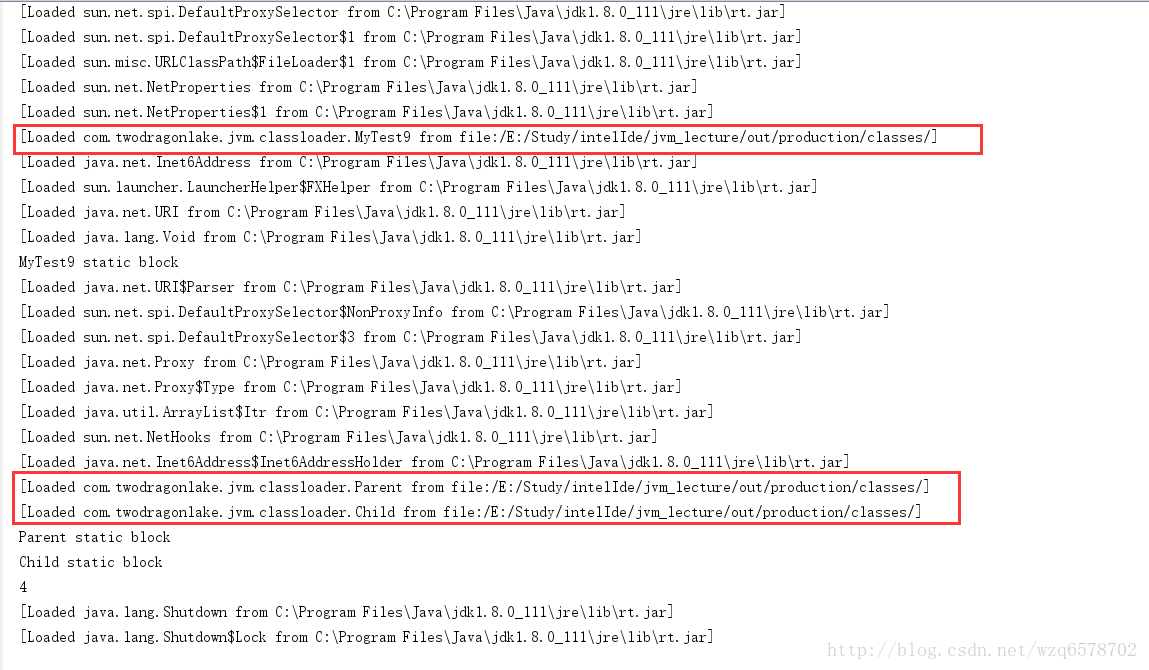exampleA:

打印结果是3 ,并且静态代码块不会执行,原因是x是常量,在编译期就会放到MyTest8的常量池当中,然后FinalTest和MyTest8就没有任何关系了,可以通过反编译的结果看到。
把x的final去掉之后,静态代码块会打印,再去看反编译结果:
1
2
3
4
5
6
7
8
9
10
11
12
13
14
15
16
17
| javap -c com.twodragonlake.jvm.classloader.MyTest8
Compiled from "MyTest8.java"
public class com.twodragonlake.jvm.classloader.MyTest8 {
public com.twodragonlake.jvm.classloader.MyTest8();
Code:
0: aload_0
1: invokespecial #1 // Method java/lang/Object."<init>":()V
4: return
public static void main(java.lang.String[]);
Code:
0: getstatic #2 // Field java/lang/System.out:Ljava/io/PrintStream;
3: getstatic #3 // Field com/twodragonlake/jvm/classloader/FinalTest.x:I
6: invokevirtual #4 // Method java/io/PrintStream.println:(I)V
9: return
}
|
可以看到main方法的iconst_3变成
1
| 3: getstatic #3 // Field com/twodragonlake/jvm/classloader/FinalTest.x:I
|
意味着MyTest8需要引用到FinalTest,两者之间存在关系的。
exampleB:
1
2
3
4
5
6
7
8
9
10
11
12
13
14
15
16
17
18
19
20
21
22
23
| class Parent{
static int x = 3;
static{
System.out.println("Parent static block");
}
}
class Child extends Parent{
static int b = 4;
static {
System.out.println("Child static block");
}
}
public class MyTest9 {
static {
System.out.println("MyTest9 static block");
}
public static void main(String[] args) {
System.out.println(Child.b);
}
}
|
打印结果:
1
2
3
| Parent static block
Child static block
4
|
即先加载运行类,然后是Parent和Child
我们可以在jvm启动参数里边加入-XX:TraceClassLoading 看到加载顺序:

exampleC:
1
2
3
4
5
6
7
8
9
10
11
12
13
14
15
16
17
18
19
20
21
22
23
24
25
26
27
28
29
30
| class Parent2{
static int a = 3;
static {
System.out.println("Parent2 static block");
}
}
class Child2 extends Parent2{
static int b = 4;
static {
System.out.println("Child2 static block");
}
}
public class MyTest10 {
static {
System.out.println("MyTest10 static block");
}
public static void main(String[] args) {
Parent2 parent;
System.out.println("-----------------");
parent = new Parent2();
System.out.println("------------------");
System.out.println(parent.a);
System.out.println("------------------");
System.out.println(Child2.b);
}
}
|
打印结果:
1
2
3
4
5
6
7
8
| MyTest10 static block
-----------------
Parent2 static block
------------------
3
------------------
Child2 static block
4
|
解析:
运行main方法之前MyTest10初始化,MyTest10的静态代码块执行
Parent2 parent;//此行代码不会发生任何作用。
System.out.println(“—————–”);
parent = new Parent2();//Parent2主动使用,触发Parent2的初始化,静态代码块被执行,打印【Parent2 static block】
System.out.println(“——————“);
System.out.println(parent.a);//打印Parent2的静态变量
System.out.println(“——————“);
System.out.println(Child2.b);//调用Child2的静态变量 触发Child2的初始化,从而执行Child2 的静态代码块,先打印Child2 static block,在打印4
exampleD:
1
2
3
4
5
6
7
8
9
10
11
12
13
14
15
16
17
18
19
20
21
22
23
24
| class Parent3{
static int a = 3;
static {
System.out.println("Parent3 static block");
}
static void doSomething(){
System.out.println("doSomething...");
}
}
class Child3 extends Parent3 {
static {
System.out.println("Child3 static block");
}
}
public class MyTest11 {
public static void main(String[] args) {
System.out.println(Child3.a); //a属于父类,属于对父类Parent3的主动使用,
//虽然名字是Child3但是却不是对Child3的主动使用,导致Parent3的初始化,然后Parent3的静态代码块被执行
Child3.doSomething();//调用父类Parent3的静态方法,是对服了的主动使用,触发父类Parent3的初始化。
}
}
|
打印结果:
1
2
3
| Parent3 static block
3
doSomething...
|
结论:
主动使用发生在静态变量定义在哪个类里边,而不是是谁调用了变量,定义变量的类会触发初始化。
exampleE:
1
2
3
4
5
6
7
8
9
10
11
12
13
14
15
16
| class CL{
static {
System.out.println("Class CL");
}
}
public class MyTest12 {
public static void main(String[] args) throws Exception {
ClassLoader classLoader = ClassLoader.getSystemClassLoader();
Class<?> cl = classLoader.loadClass("com.twodragonlake.jvm.classloader.CL");////不会触发类的初始化
System.out.println(cl);
System.out.println("-------------------------");
cl = Class.forName("com.twodragonlake.jvm.classloader.CL");////使用了反射,这属于类初始化时机的反射时机。会触发类的初始化。
System.out.println(cl);
}
}
|
打印结果:
1
2
3
4
| class com.twodragonlake.jvm.classloader.CL
-------------------------
Class CL
class com.twodragonlake.jvm.classloader.CL
|
调用classLoader类的loadClass方法加载一个类,并不是对类的主动使用,不会导致类的初始化
这个例子验证了类的初始化时机的反射时机,具体参考之前的文章:主动使用(七种)

